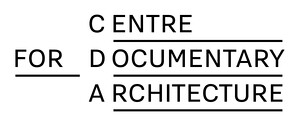September 27–November 3, 2019
Stéphane-Hessel-Platz 1
99423 Weimar
Germany
The project The Matter of Data relates the migration history of so-called “Bauhaus modernism” to the logistics of exporting structural components and building materials from Germany to Palestine in the 1930s. Using the Centre for Documentary Architecture’s (CDA) methods of documentation and digital analysis, the Max Liebling House in Tel Aviv is explored as an illustrative nexus of the White City’s complex history. The exhibition links film and archival studies, material analyses, and digital building surveys within a comprehensive data platform, thereby presenting architecture as a document of historical and political relations.
Bauhaus modernism refers to the narratives of the three Bauhaus schools—Weimar, Dessau and Berlin, the stories of their protagonists and works, the diaspora that resulted from the Bauhaus, and the modern architecture associated with this movement. As the space of modernism seems so utterly fractured, this exhibition is devoted to the question of how we can capture, reconnect to and reengage a diffused body of knowledge. In this exhibition, following a cross-border and an open-data approach, the Centre for Documentary Architecture presents the methods of its namesake, documentary architecture. Using digital research techniques and archives, it aims to open up a geography of Bauhaus modernism. For it is in the materiality of buildings that historical and political forces can be seen to manifest themselves. The conceptual matrix that comprises this exhibition is thus organized along two axes: matter and data. This exhibition is based on a growing digital archive collected by the Centre for Documentary Architecture, which includes material analysis, documentations and interviews as it engages with the history of modernism and its various afterlives.
At the centre of this exhibition is a material documentation and digital analysis of the Max Liebling House built by Dov Karmi in Tel Aviv in 1937. This study of the building takes the viewer across different locations and periods, scales and durations. The design of the building is traced to debates undertaken in architectural schools associated with the modernist movement in Germany and in Europe during the interwar period, including the Bauhaus. It connects the story of the building’s inhabitants to trajectories of exile and forced migration after the rise of the Hitler regime. It finds traces of the building materials imported to Palestine from Nazi Germany, and it looks at the growth of Tel Aviv’s White City in relation to the emergence of other modernist cities across the Orient.
Including an 8-screen-video wall, a comprehensive data platform, a table presenting an archive of documents, interviews and objects, a model and a woven carpet, the exhibition thus presents architecture as a solidification of complex historical and political relations, movements and flows, of matter and data.
A project by the Centre for Documentary Architecture under the direction of Ines Weizman. On the initiative of the Bauhaus Kooperation Berlin Dessau Weimar in collaboration with the Bauhaus-Universität Weimar. On the occasion of 100 jahre bauhaus as part of the Triennale of Modernism 2019. Supported by the Federal Foreign Office and the “Federal Government Commissioner for Culture and the Media” based on a decision of the German Bundestag.

